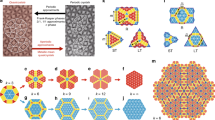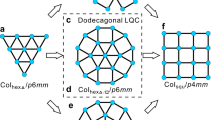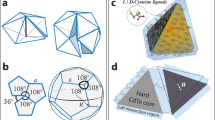Abstract
The tiling of surfaces has long attracted the attention of scientists, not only because it is intriguing intrinsically, but also as a way to control the properties of surfaces. However, although random tiling networks are studied increasingly, their degree of randomness (or partial order) has remained notoriously difficult to control, in common with other supramolecular systems. Here we show that the random organization of a two-dimensional supramolecular array of isophthalate tetracarboxylic acids varies with subtle chemical changes in the system. We quantify this variation using an order parameter and reveal a phase behaviour that is consistent with long-standing theoretical studies on random tiling. The balance between order and randomness is driven by small differences in intermolecular interaction energies, which can be related by numerical simulations to the experimentally measured order parameter. Significant variations occur with very small energy differences, which highlights the delicate balance between entropic and energetic effects in complex self-assembly processes.
This is a preview of subscription content, access via your institution
Access options
Subscribe to this journal
Receive 12 print issues and online access
$259.00 per year
only $21.58 per issue
Buy this article
- Purchase on Springer Link
- Instant access to full article PDF
Prices may be subject to local taxes which are calculated during checkout



Similar content being viewed by others
References
Elemans, J. A. A. W., Lei, S. & De Feyter, S. Molecular and supramolecular networks on surfaces: from two-dimensional crystal engineering to reactivity. Angew. Chem. Int. Ed. 48, 7298–7332 (2009).
Bartels, L. Tailoring molecular layers at metal surfaces. Nature Chem. 2, 87–95 (2010).
Blunt, M. O. et al. Random tiling and topological defects in a two-dimensional molecular network. Science 322, 1077–1081 (2008).
Otero, R. et al. Elementary structural motifs in a random network of cytosine adsorbed on a gold(111) surface. Science 319, 312–315 (2008).
Marschall, M. et al. Random two-dimensional string networks based on divergent coordination assembly. Nature Chem. 2, 131–137 (2010).
Zhou, H. et al. Frustrated 2D molecular crystallization. J. Am. Chem. Soc. 129, 13774–13775 (2007).
Fisher, M. E. Statistical mechanics of dimers on a plane lattice. Phys. Rev. 124, 1664–1672 (1961).
Kasteleyn, P. W. Dimer statistics and phase transitions. J. Math. Phys. 4, 287–297 (1963).
Henley, C. L. in Quasicrystals, the State of the Art (eds Di Vincenzo, D. P. & Steinhardt, P. J.) Ch. 15 (World Scientific, 1999).
Destainville, N. Flip dynamics in octagonal rhombus tiling sets. Phys. Rev. Lett. 88, 030601 (2002).
Wilson, D. B. Mixing times of lozenge tiling and card shuffling Markov chains. Ann. Appl. Probab. 14, 274–325 (2004).
Lu, P. J. & Steinhardt, P. J. Decagonal and quasi-crystalline tilings in medieval Islamic architecture. Science 315, 1106–1110 (2007).
Alet, F., Ikhlef, Y., Jacobsen, J. L., Misguich, G. & Pasquier, V. Classical dimers with aligning interactions on the square lattice. Phys. Rev. E 74, 041124 (2006).
Papanikolaou, S., Luijten, E. & Fradkin, E. Quantum criticality, lines of fixed points, and phase separation in doped two-dimensional quantum dimer models. Phys. Rev. B 76, 134514 (2007).
Castelnovo, C., Chamon, C., Mudry, C. & Pujol, P. Zero-temperature Kosterlitz–Thouless transition in a two-dimensional quantum system. Ann. Phys. 322, 903–934 (2007).
Jacobsen, J. L. & Alet, F. Semiflexible fully packed loop model and interacting rhombus tilings. Phys. Rev. Lett. 102, 145702 (2009).
Lackinger, M. & Heckl, W. M. Carboxylic acids: versatile building blocks and mediators for two-dimensional supramolecular self-assembly. Langmuir 25, 11307–11321 (2009).
Zhao, J. F. et al. Molecule length directed self-assembly behaviour of tetratopic oligomeric phenylene–ethynylenes end-capped with carboxylic groups by scanning tunneling microscopy. J. Phys. Chem. C 114, 9931–9937 (2010).
Blunt, M. et al. Directing two-dimensional molecular crystallization using guest templates. Chem. Commun. 2304–2306 (2008).
Kampschulte, L. et al. Solvent induced polymorphism in supramolecular 1,3,5-benzenetribenzoic acid monolayers. J. Phys. Chem. C 110, 10829–10836 (2006).
Tahara, K. et al. Two-dimensional porous molecular networks of dehydrobenzo[12]annulene derivatives via alkyl chain interdigitation. J. Am. Chem. Soc. 128, 16613–16625 (2006).
Furukawa, S. et al. Structural transformation of a two-dimensional molecular network in response to selective guest inclusion. Angew. Chem. Int. Ed. 46, 2831–2834 (2007).
Griessl, S. J. H. et al. Incorporation and manipulation of coronene in an organic template structure. Langmuir 20, 9403–9407 (2004).
Wu, D., Deng, K., He, M., Zeng, Q. & Wang, C. Coadsorption-induced reconstruction of supramolecular assembly characteristics. ChemPhysChem 8, 1519–1523 (2007).
Garrahan, J. P., Stannard, A., Blunt, M. O. & Beton, P. H. Molecular random tilings as glasses. Proc. Natl Acad. Sci. USA 106, 15209–15213 (2009).
Stannard, A., Blunt, M. O., Beton, P. B. & Garrahan, J. P. Entropically stabilized growth of a two-dimensional random tiling. Phys. Rev. E 82, 041109 (2010).
Gutzler, R. et al. Reversible phase transitions in self-assembled monolayers at the liquid–solid interface: temperature-controlled opening and closing of nanopores. J. Am. Chem. Soc. 132, 5084–5090 (2010).
Yang, Y. and Wang, C. Curr. Opin. Colloid Interface Sci. 14, 135–147 (2009).
Blunt, M. O. et al. Guest-induced growth of a surface-based supramolecular bilayer. Nature Chem. 3, 74–78 (2011).
Cook, J. L., Hunter, C. A., Low, C. M. R., Perez-Velasco, A. & Vinter, J. G. Solvent effects on hydrogen bonding. Angew. Chem. Int. Ed. 46, 3706–3709 (2007).
Acknowledgements
We thank the UK Engineering and Physical Sciences Research Council (EPSRC) for financial support under grant EP/D048761/01. J.P.G. was supported by EPSRC Grant No. GR/S54074/01. A.S. was supported by the Leverhulme Trust (ECF/2010/0380) and the EPSRC (EP/P502632/1). M.S. acknowledges receipt of a Royal Society Wolfson Merit Award and an European Research Council Advanced Grant. N.R.C. acknowledges receipt of a Royal Society Leverhulme Trust Senior Research Fellowship.
Author information
Authors and Affiliations
Contributions
A.S., J.C.R., M.O.B., J.P.G., N.R.C. and P.H.B. designed and conceived the experiment, A.S., J.C.R. and M.O.B. performed the experiments, A.S. and J.P.G. performed the numerical simulations, C.S., M.C.G-L., N.T., M.S. and N.R.C. prepared the materials, A.S., J.P.G., M.O.B., J.C.R. and P.H.B. analysed the data, A.S., J.P.G. and P.H.B. co-wrote the paper and all authors provided revisions and comments on the manuscript.
Corresponding authors
Ethics declarations
Competing interests
The authors declare no competing financial interests.
Supplementary information
Supplementary information
Supplementary information (PDF 273 kb)
Rights and permissions
About this article
Cite this article
Stannard, A., Russell, J., Blunt, M. et al. Broken symmetry and the variation of critical properties in the phase behaviour of supramolecular rhombus tilings. Nature Chem 4, 112–117 (2012). https://doi.org/10.1038/nchem.1199
Received:
Accepted:
Published:
Issue Date:
DOI: https://doi.org/10.1038/nchem.1199
This article is cited by
-
Construction and nanotribological study of a glassy covalent organic network on surface
Nano Research (2022)
-
Complex k-uniform tilings by a simple bitopic precursor self-assembled on Ag(001) surface
Nature Communications (2020)
-
Designing disorder into crystalline materials
Nature Reviews Chemistry (2020)
-
Ordering, flexibility and frustration in arrays of porphyrin nanorings
Nature Communications (2019)
-
Two-dimensional tessellation by molecular tiles constructed from halogen–halogen and halogen–metal networks
Nature Communications (2018)



